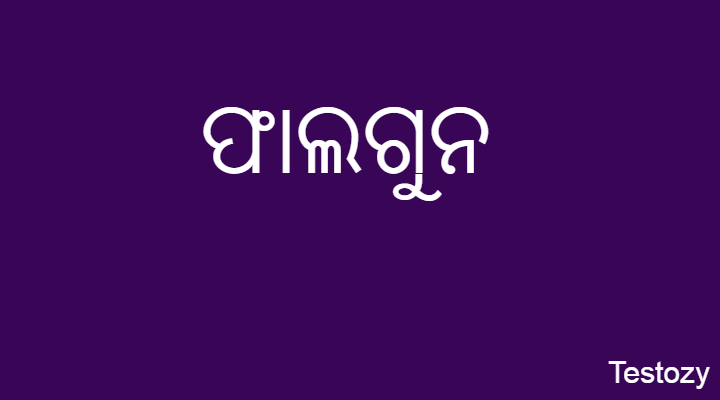12 Months Name in Odia
Hello Friends, Welcome to Testozy. Here in this article you are going to know about the 12 Months name in Odia. There are separate name for 12 months in Odia language. These Months have their own significance. The 12 month in Odia is unique and also have some meaning behind it. here we will give you the list of 12 month in Odia and also provide you image for the 12 month in odia. we here also connected the 12 month of Odia with 12 english month for convenience. So Here is the 12 months name in Odia with image.
The 12 Months of Odia Calendar
- ବୈଶାଖ (Baisakha)
- ଜେଷ୍ଠ (Jyestha)
- ଆଷାଢ (Ashadha)
- ଶ୍ରାବଣ (Shravana)
- ଭାଦ୍ରବ (Bhadraba)
- ଅଶ୍ଵିନ (Ashwin)
- କାର୍ତ୍ତିକ (Kartika)
- ମାର୍ଗଶିର (Margashira)
- ପୌଷ (Pausa)
- ମାଘ (Magha)
- ଫାଲଗୁନ (Phalguna)
- ଚୈତ୍ର (Chaitra)
1. Baisakh (ବୈଶାଖ):
Vaisakha is a month in the Hindu calendar that marks the beginning of changing weather conditions. It usually happens in April or May. It is a significant month with many regional and religious festivals taking place. It is also associated with new beginnings and starting fresh.
2. Jyestha (ଜ୍ୟେଷ୍ଠ):
Jyeshtha is the hottest month of the year and comes after Vaisakha. It typically happens in May or June. During this month, the weather can be very hot and humid. People take extra care to stay hydrated and cool. Some important festivals also happen during this time.
3. Asadha (ଆଷାଢ଼):
Ashadha is a month that falls in June or July. It marks the beginning of the monsoon season in many regions. It is a time of relief from the summer heat and the arrival of much-needed rain. This month is also associated with the farming community, as it brings new opportunities for cultivation.
4. Shravana (ଶ୍ରାବଣ):
Shravana falls in July or August and is considered an auspicious month in the Hindu calendar. It is associated with devotion and worship. Many people observe fasts and offer prayers to Lord Shiva during this time. It is also a month of festivals and celebrations.
5. Bhadraba (ଭାଦ୍ରବ):
Bhadraba takes place in August or September. It is a month of transition, as it marks the end of the monsoon season and the beginning of autumn. This month is known for the festival of Ganesh Chaturthi, where Lord Ganesha, the elephant-headed deity, is worshipped with great enthusiasm.
6. Ashwina (ଅଶ୍ଵିନ):
Ashwina typically occurs in September or October. It is a festive month with several important Hindu festivals, including Navratri and Dussehra. These festivals celebrate the victory of good over evil and are marked by prayers, fasting, dancing, and cultural performances.
7. Kartika (କାର୍ତ୍ତିକ):
Kartika falls in October or November. It is a significant month in which the festival of Diwali is celebrated. Diwali, also known as the festival of lights, symbolizes the victory of light over darkness and good over evil. It is a time for families to come together, light lamps, exchange gifts, and enjoy delicious sweets.
8. Margashira (ମାର୍ଗଶିର):
Margashirsha occurs in November or December. It is a sacred month, often associated with devotion and offering prayers to Lord Vishnu. Many people observe fasts on Ekadashi, a day dedicated to Lord Vishnu, and perform religious rituals.
9. Pousha (ପୌଷ):
Pausa falls in December or January. It is a quiet month marked by winter and a time for reflection and introspection. People often spend time in spiritual activities, such as reading scriptures, practicing meditation, and engaging in acts of charity.
10. Magha (ମାଘ):
Magha takes place in January or February. It is a significant month as it includes the festival of Makar Sankranti. Makar Sankranti symbolizes the transition of the sun into the zodiac sign of Capricorn. This festival is celebrated with kite flying, bonfires, and feasting.
11. Phalguna (ଫାଲଗୁନ ):
Phalguna typically occurs in February or March. It is a month filled with festivities, including the colorful festival of Holi. Holi is a vibrant celebration of the arrival of spring, where people play with colors, dance, and enjoy sweets.
12. Chaitra (ଚୈତ୍ର):
Chaitra falls in March or April and marks the end of the Hindu calendar year. It is a month of new beginnings and is associated with the festival of Navratri, which celebrates the divine feminine energy. The last day of Chaitra is celebrated as Gudi Padwa, the Hindu New Year.
Conclusion
The twelve months in Odia not only represent the changing seasons but also carry deep cultural and religious significance. Each month brings with it a sense of anticipation for the festivals and celebrations it holds. The unique names given to the months reflect the creativity and artistic sensibilities of the Odia language. Celebrating these festivals and observing the traditions is a way for the people of Odisha to connect with their roots and preserve their cultural heritage.
FAQs
1. What is the Odia New Year month?
2. When does the Rath Yatra take place in Odisha?
3. Which festival is celebrated during the month of Ashwina?
4. What is the significance of Kartika Purnima in Odisha?










.png)



